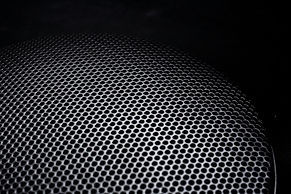
Let your ears be the judge! Your factory speakers may sound okay to your ears, but have you wondered what better sounds like? It's no secret that factory car speakers are designed to be cost-effective, not great sounding. Quality aftermarket speakers allow you to enjoy your music loud and clear. There are lots of options for every budget and musical preference, as well as different sizes and types to fit whatever you drive. Take the first step to better sound by upgrading your speakers!






FEATURED ITEMS

TWEETERS
The small speaker responsible for conveying upper high-end (treble) sound frequencies.
TWO-WAY SPEAKER
A speaker that consists of two drivers: one large woofer to produce the lower frequencies and a small tweeter that produces the high frequencies.
IMPEDENCE
Impedance is commonly listed from 4 to 8 ohms, with some ranging from 1 to 16 ohms. This is a technical description of the amount of inductive resistance a speaker offers to the flow of electrical signals from a receiver. Under normal circumstances, impedance bears no relation to sound quality, but many receivers need a minimum of 4 ohms to work properly. A good amplifier may work with 2 ohms, but other receivers or amplifiers will automatically shut off or blow a fuse. If you intend to use two pairs of speakers in parallel from the same terminals, choose loudspeakers rated at least 8 ohms. Also note that speaker impedance ratings are nominal, meaning that a speaker may actually fall below its rated impedance at some frequencies.
BIAMPLIFICATION
A system that uses separate circuits of amplification to feed the individual speaker components.
OEM (Original Equipment Manufacturer)
This refers to the factory-installed system that comes with a car. Many car manufacturers are using name brand products, either standard or part of an upgrade package. The speakers tend to be very poorly made when compared to aftermarket products.
POWER REQUIREMENTS
Different speakers take advantage of different physical properties to produce sound. Too much power can damage speakers, but speaker ratings and amplifier ratings don't always tell the whole story. Speakers rated at 100 watts maximum may safely be powered by a 300-watt amplifier, but if you force all 300 watts into the speaker, the sound will cause you pain and damage the speakers. Too little power can also damage a speaker. If you try to play a low-powered amplifier too loudly it can distort the sound waves, and this distortion can destroy a speaker. Power ratings are listed as either "Peak" or "RMS" (Root Mean Square.) Peak listing in the amount of power the equipment can handle momentarily--a sharp drum hit, for example. RMS is a better indication of the overall performance, since it is a measurement of the average sustained power.
DYNAMIC RANGE
The difference between the loudest peak and softest passage. It can also refer to the spectrum between the edge of distortion at the high end of a product's performance and the product's noise floor.
DISTORTION
This is a measurement of the deviation from the original signal to the reproduced signal. Distortion is a harsh sounding artifact that alters, in a negative way, the signal.
FREQUENCY RESPONSE
Also listed as Frequency range, is the spectrum of frequencies produced by a product, within a certain tolerance. For example, a frequency response of 30Hz to 18kHz (+/- 3dB) means a product produces all frequencies from 30Hz to 18kHz without dropping or peaking three decibels. The signal below and above that range does drop off more than 3dB, so the range is really the usable spectrum of sound.
SENSITIVITY
Also referred to efficiency. This is a measure of how effectively a speaker can convert electrical power from an amplifier into acoustic sound energy. The higher this number, the more sound you will get at a given volume setting. This is typically measured from one meter away from the speaker with an input signal of 2.83 volts (1 watt at 8 ohms) which results in a sound pressure level, listed in decibels.
The experts at Foss Audio & Tint have a great deal of experience installing speakers in all types of vehicles. We support and sell the best brands including Pioneer, Kenwood, Alpine and others. Call us or drop by today and we’ll be happy to discuss the best options for you. Also be sure to check out our promotions page to see if we’re running any specials on speakers.










